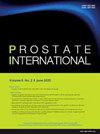钬激光前列腺摘除与前列腺动脉栓塞的疗效和安全性比较:近期随访结果
IF 2.6
2区 医学
Q2 UROLOGY & NEPHROLOGY
引用次数: 0
摘要
目的:良性前列腺增生的治疗方案多种多样。钬激光前列腺去核术(HoLEP)和前列腺动脉栓塞术(PAE)已成为治疗前列腺增生的新方法。然而,这两种技术之间存在有限的比较证据。因此,我们通过短期随访调查了它们的疗效和不良事件。材料和方法本前瞻性研究回顾了329例HoLEP (n = 249)或PAE (n = 80)患者的医疗记录。测量国际前列腺症状评分(IPSS)、IPSS生活质量(QoL)、最大尿流率(MFR)和空后残留尿(PVR)来评估疗效。对于不良事件,评估国际勃起功能指数-5 (IIEF-5)、男性性健康问卷(MSHQ -简表)和手术相关并发症。在基线和手术后1个月和3个月比较两种治疗内和两种治疗之间的所有变量。结果两组共匹配108例患者,各组基线特征平衡。IPSS、IPSS QoL、MFR和PVR在每次手术后均有改善。然而,与PAE相比,从基线到3个月,HoLEP在IPSS、IPSS QoL、MFR和PVR方面取得了更大的改善(均P <; 0.05)。在性功能方面,与同期的HoLEP相比,PAE更好地保存了勃起功能(P = 0.001)和射精功能(P = 0.001)。HoLEP组总体不良事件发生率(28.1%)高于PAE组(10%)(相对危险度3.19;95%可信区间1.61 ~ 6.34,P = 0.009)。1例阴茎龟头坏死,一个独特的不良事件,观察后PAE。结论HoLEP和PAE能在短期内显著改善下尿路症状。然而,与PAE相比,HoLEP提供了更好的疗效,但与性功能保存较少和不良事件发生率较高相关。本文章由计算机程序翻译,如有差异,请以英文原文为准。
Comparison of the efficacy and safety of holmium laser enucleation of the prostate and prostate artery embolization: Short-term follow-up results
Purpose
The treatment options for benign prostatic hyperplasia vary. Holmium laser enucleation of the prostate (HoLEP) and prostate artery embolization (PAE) have emerged as novel surgical treatments for benign prostatic hyperplasia. However, limited comparative evidence exists between these two techniques. Thus, we investigated their efficacy and adverse events with a short-term follow-up.
Materials and methods
This prospective study reviewed the medical records of 329 patients who underwent HoLEP (n = 249) or PAE (n = 80). The International Prostate Symptom Score (IPSS), IPSS Quality of Life (QoL), maximal flow rate (MFR), and post-void residual urine (PVR) were measured to assess efficacy. For adverse events, the International Index of Erectile Function-5 (IIEF-5), the Male Sexual Health Questionnaire (MSHQ)-Short Form, and procedure-related complications were evaluated. All variables were compared within and between the two treatments at baseline and 1 and 3 months after the procedure.
Results
A total of 108 patients were matched for each group and baseline characteristics were balanced between the groups. The IPSS, IPSS QoL, MFR, and PVR improved following each procedure. However, compared with PAE, HoLEP achieved greater improvements in the IPSS, IPSS QoL, MFR, and PVR from baseline to 3 months (all P < 0.05). In terms of sexual function, PAE better preserved both erectile (P = 0.001) and ejaculatory (P = 0.001) function compared with HoLEP over the same period. The overall incidence of adverse events was higher with HoLEP (28.1%) than with PAE (10%) (relative risk 3.19; 95% confidence interval 1.61–6.34, P = 0.009). One case of penile glans necrosis, a unique adverse event, was observed following PAE.
Conclusions
In the short term, HoLEP and PAE can significantly improve lower urinary tract symptoms. However, compared with PAE, HoLEP provides superior efficacy yet is associated with less preservation of sexual function and a higher rate of adverse events.
求助全文
通过发布文献求助,成功后即可免费获取论文全文。
去求助
来源期刊

Prostate International
Medicine-Urology
CiteScore
4.40
自引率
26.70%
发文量
40
审稿时长
35 days
期刊介绍:
Prostate International (Prostate Int, PI), the official English-language journal of Asian Pacific Prostate Society (APPS), is an international peer-reviewed academic journal dedicated to basic and clinical studies on prostate cancer, benign prostatic hyperplasia, prostatitis, and ...
 求助内容:
求助内容: 应助结果提醒方式:
应助结果提醒方式:


